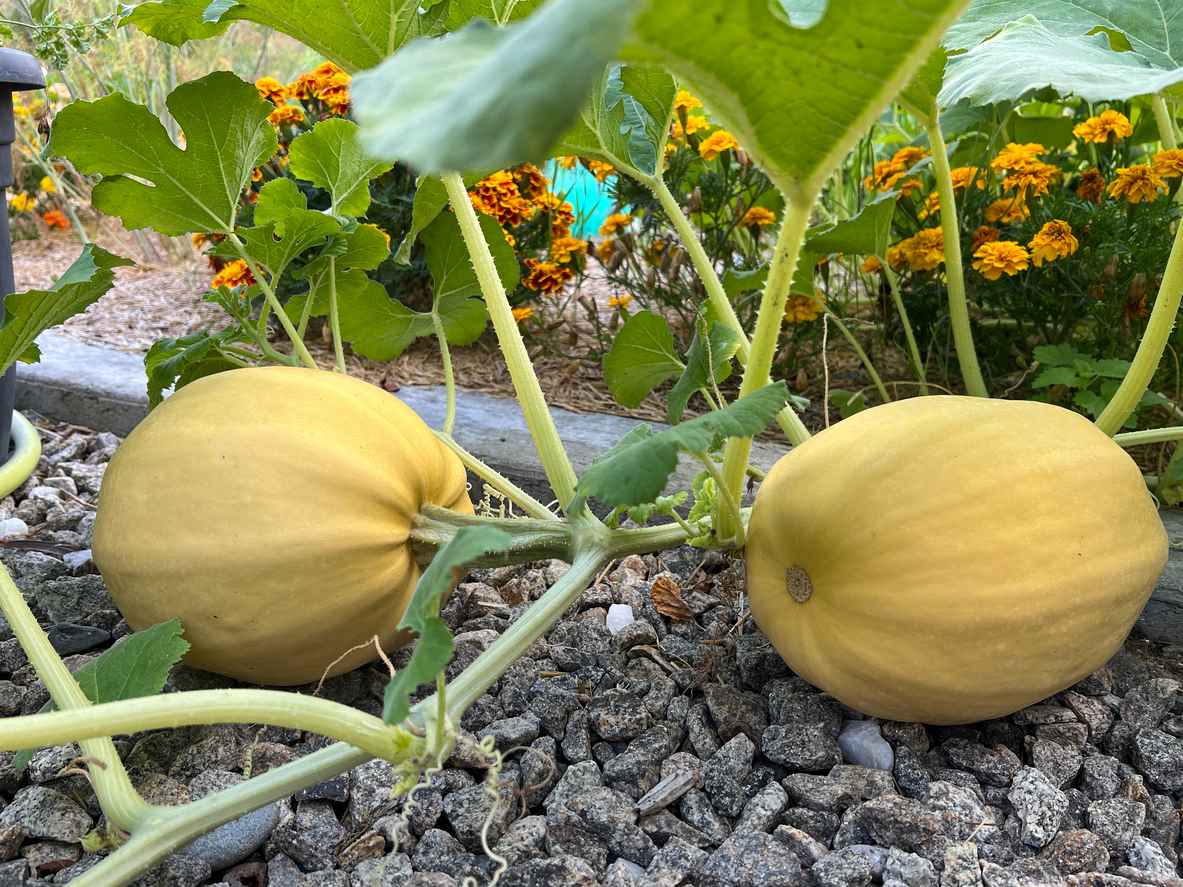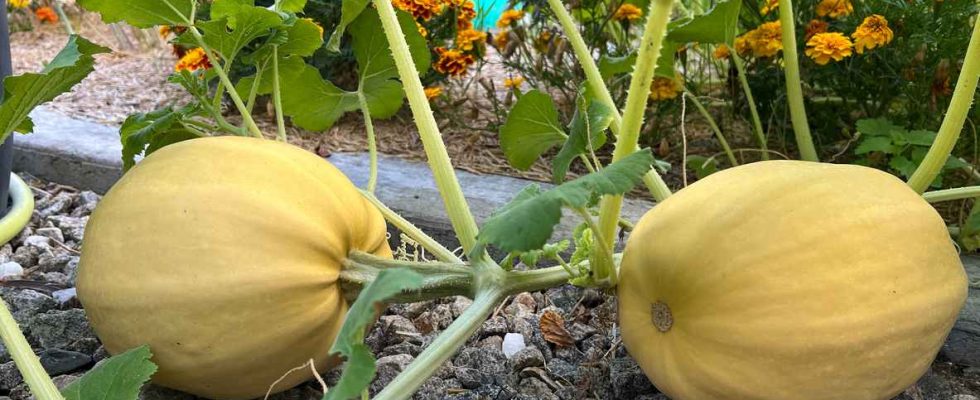
Spaghetti squash
From the Cucurbitaceae family, spaghetti squash is easy to grow and will reward you for your efforts with 2 to 5 fruits per plant, approximately 3 kg each. Its name comes from its flesh which, after cooking, creates sort of firm filaments reminiscent of the famous Italian pasta, spaghetti.
It owes to this culinary originality the pride of place that it has now carved out for itself in our vegetable gardens. Here are some things to remember about spaghetti squash:
- Its flesh does not present much taste interest.but it is low in calories and rich in many vitamins, such as provitamin A and vitamin B, and can be prepared and eaten like spaghetti, in tomato sauce or carbonara, among many other recipes.
- Although the most common variety of this annual plant is characterized by bright yellow skin and pale yellow flesh, it comes in different other varieties which can be differentiated by their color, some being creamy green with stripes or spots, others white, orange, etc.
- Spaghetti squash presents the same thorny stems and the same downy foliage than other cucurbits.
Growing Spaghetti Squash
Spaghetti squash identity and cultivation sheet
Latin name | Cucurbita pepo |
Other name | Vegetable spaghetti |
| Family | Cucurbits |
| Exposure | Sun |
| Soil type | Humous soil, fresh |
| Cold resistance | Not frost resistant |
Reasonable planting period | From April to July, the best time slot being from May to June |
| Harvest period | From August to November, depending on the planting time and climate in your area |
| Diseases and pests | Powdery mildew, aphids, snails and slugs |
Spaghetti Squash Needs
Whether you grow it in your vegetable patch or in your garden, you can let it run on the ground or install it against a trellis, an arbor, etc. to make it climb. For a productive plant, it is important to meet its needs:
- Ground side : it needs rich soil. This means that you should not hesitate to bring compost to the areas where you are going to cultivate it.
- Exhibition side : you should preferably install it in a sunny location.
- Temperature side : Spaghetti squash being a chilly plant, you must wait until all risk of frost has passed before putting your plants in the ground.
- Watering side : it needs a lot of water. To preserve the freshness of the soil, you can use mulching.
Companion plants
You can grow spaghetti squash near beans and cabbages whose company it enjoys. Conversely, avoid installing it near potatoes.
Sowing
The best time to sow under cover, in light and a temperature of at least 12°C East the month of April. Here’s how to do it:
- In each bucket filled with potting soil, place 2 to 3 seeds on the edge.
- Cover with a little earth.
- Water.
- During germination, make sure to keep the soil always moist and that the temperature does not drop below 12°. You can use a sprayer to keep the substrate moist, but not excessively.
- The seeds emerge after 10 to 15 days.
- If the risk of frost has passed, transplanting into the ground can be done 3 weeks later, allowing a space of 1 meter between each plant, because it is a plant that needs space.
You can also sow directly in the ground from May.
Interview
Here are some tips for having productive plants:
- To stimulate the development of your plants, remember to pinch the stems above the 3rd or 4th leaf.
- Install mulch at the base of your squash. The latter will keep the soil moist and limit the appearance of weeds.
- Do not hesitate to water as soon as the soil becomes too dry. But be careful to water the base, without wetting the foliage.
- When the fruits develop, you can place them on mulcha tile or other support to prevent the squash from touching the ground and rotting.
Harvest
It is approximately 80 to 110 days after sowing, generally between September and November, when you can harvest. In any case, be sure to harvest your squash before frost, as they will not resist it.
To know if your squash is ripe, simply look at the stem. In fact, it splits and resembles cork when the fruit is ready to be harvested.
To harvest the fruit, it is important to cut it as close as possible to the stem, leaving the peduncle intact. This will prevent your squash from rotting too quickly. Before bringing in your harvest, let it dry in the sun for a day. Here again, this precaution will prevent premature rotting.
Conservation
The spaghetti squash can then be stored for several months :
- If you have a lot of them, store them in a dry and ventilated room, at a temperature between 12 and 20°C.
- If you only have a small amount, you can store them in a cupboard in your kitchen.
Once the squash is opened, it should be eaten quickly.
As with all squash, the seeds can also be eaten.
Diseases and pests
Spaghetti squash are quite tough, but they still have a few enemies.
Powdery mildew
In the event of excessive humidity associated with excessive heat, squash is susceptible to powdery mildew, also known as “powder powder”. It is a fungus that grows leaving a white powder on the leaves and fruits. The plant will then turn yellow and die if nothing is done. You must therefore monitor the appearance of these signs, particularly during periods of stormy weather, and pull out diseased plants without delay.
Snails and slugs
Like all plants, spaghetti squash can fall victim to the gluttony of these molluscs, especially when the plant is still young. You can protect your plants by putting coffee grounds, broken egg shells, etc. at their foot, or by preparing a fern manure.
Aphids
They can attack the stems of young plants. To eliminate aphids, prepare a mixture of black soap and water and spray it on the infested plant.

